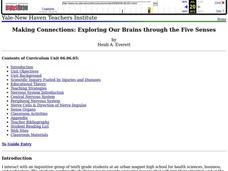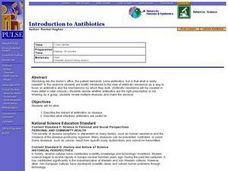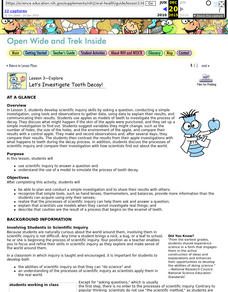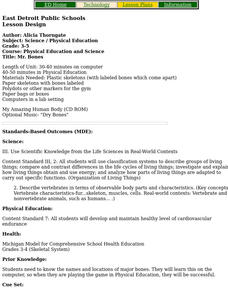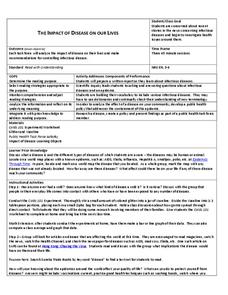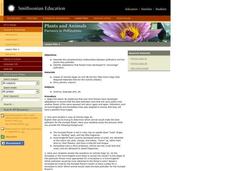Curated OER
Stranger Than Fiction
Students reflect on the importance of science literacy. They review the year's science curriculum by reading, discussing and writing questions on teacher-selected New York Times articles and the related science content.
Curated OER
What's Air Got to Do with It?
Students use M&M's to create a pie graph that expresses their understanding of the composition of air. They watch and conduct several simple experiments to develop an understanding of the properties of air (it has mass, it takes up...
Curated OER
Air and Water in the Environment
Young scholars explore the traits of water condensation and evaporation. In this water cycle lesson plan, students develop an awareness of the importance of water for sustaining life. Young scholars participate in a hands-on activity in...
Curated OER
Communications
Students incorporate different disciplines into this lesson. In this science lesson, students investigate the use of communicating without words, and how it is different than communicating with words. They discuss the pros and cons of...
Curated OER
Making Connections: Exploring Our Brains through the Five Senses
Students record observations and create drawings and models of anatomy using their five senses. They describe the structures of a neuron and analyze each of their functions. They compare and contrast the typical structural features of a...
Curated OER
Making Connections: Exploring Our Brains through the Five Senses
Students identify structures of the brain, and neurons and analyze their functions. In this nervous system instructional activity students create drawings and models of anatomy.
Curated OER
The Mysterious Tragedy at Lake Nyos
Students present a convincing explanation of the Lake Nyos event and propose a solution to prevent future tragedies at central and western African lakes.
Curated OER
From Foraging to Farming
Students experience the difficulty that goes along with foraging for food. In this lesson on the importance of modern agriculture, students simulate how there simply is not enough food and water for everyone when agricultural means are...
Curated OER
Bouncing off the Wall
Students watch a video clips before problem solving the use of angles in real world situations. They problem solve using spatial reasoning while connecting math to a sports activity that investigates the path of a bouncing ball.
Curated OER
Holidays: Stress on the Body
Students read an article on stress and holiday weight gain. For this biology lesson, students research about the body's response to excess sugar in the diet. They create a pamphlet, billboard, newscast or journal article containing...
Baylor College
Global Atmospheric Change: The Math Link
Change up the classroom atmosphere with this interdisciplinary resource. Following along with the children's book Mr. Slaptail's Curious Contraption, these math worksheets provide practice with a wide range of topics including...
Curated OER
Introduction to Antibiotics
High schoolers describe the impact of antibiotics on disease. They describe what infections antibiotics are useful for. Students are introduced to the idea of antibiotic resistance as a way to focus on antibiotics and the mechanisms by...
Curated OER
Next Year's Seeds
Sixth graders explore agricultural issues using math and probabilities. In this agriculture lesson, 6th graders investigate real world situations in agriculture using math and probabilities.
Curated OER
Let's Investigate Tooth Decay
Students conduct a simple investigation to explore tooth decay.
Curated OER
Genetically Modified Foods
High schoolers explain what genetically modified foods are and how they are created. Students use appropriate vocabulary to describe and effectively discuss the benefits of, and potential risks of, genetically modified foods.
Curated OER
People and the Ocean
Young scholars view a demonstration of the ocean and what we can do to help it, and also identify seafood items that students would order on a menu. In this ocean lesson plan, young scholars learn how people are connected to the ocean...
Curated OER
Lesson 5: Technology: Conveniences and Consequences
Students identify positive and negative impacts of technology. In this technological advancements lesson, students consider how toxic pollution affects the Earth and its inhabitants. Students participate in 3 activities that allow them...
Curated OER
Who am I and Why?
Students make comparisons about themselves and others, which are real and meaningful. They study some basic concepts in the area of genetics and do a complimentary series of experiments, or explorations that illustrate these concepts
Curated OER
Disease and Epidemics
Students watch a video to introduce the study of historical outbreaks of infectious diseases and epidemics. They create charts of diseases after reading an article and share their information as a class.
Curated OER
Mr. Bones
Students play CD-ROM game My Amazing Human Body, and participate in relay game in Phys. Ed. where they put together skeleton on which body parts are labeled.
Curated OER
Mosquito Bytes
Students investigate mosquitoes. In this mosquito bytes lesson, students consider reasons why mosquitoes transfer disease and ways to combat them. Students read an article, discuss, and complete a quiz.
Curated OER
The Impact of Disease on Our Lives
Students write a report about infectious diseases where they demonstrate their understanding of new terminology. In this writing instructional activity, students analyze the effect of disease in their lives and and make scientific...
Curated OER
Plants and Animals, Partners in Pollination
Students participate in multiple hands-on activities to explore reproduction and pollination. In groups, using a cotton swab and powder, students simulate being pollinators and plants. They name the parts of the flowers and the function...
Curated OER
Plants and Animals: Partners in Pollination
Young scholars describe the complementary relationships between pollinators and the plants they pollinate, identify adaptations that flowers have developed to "encourage" pollination, and create and draw their own "designer" flowers.







